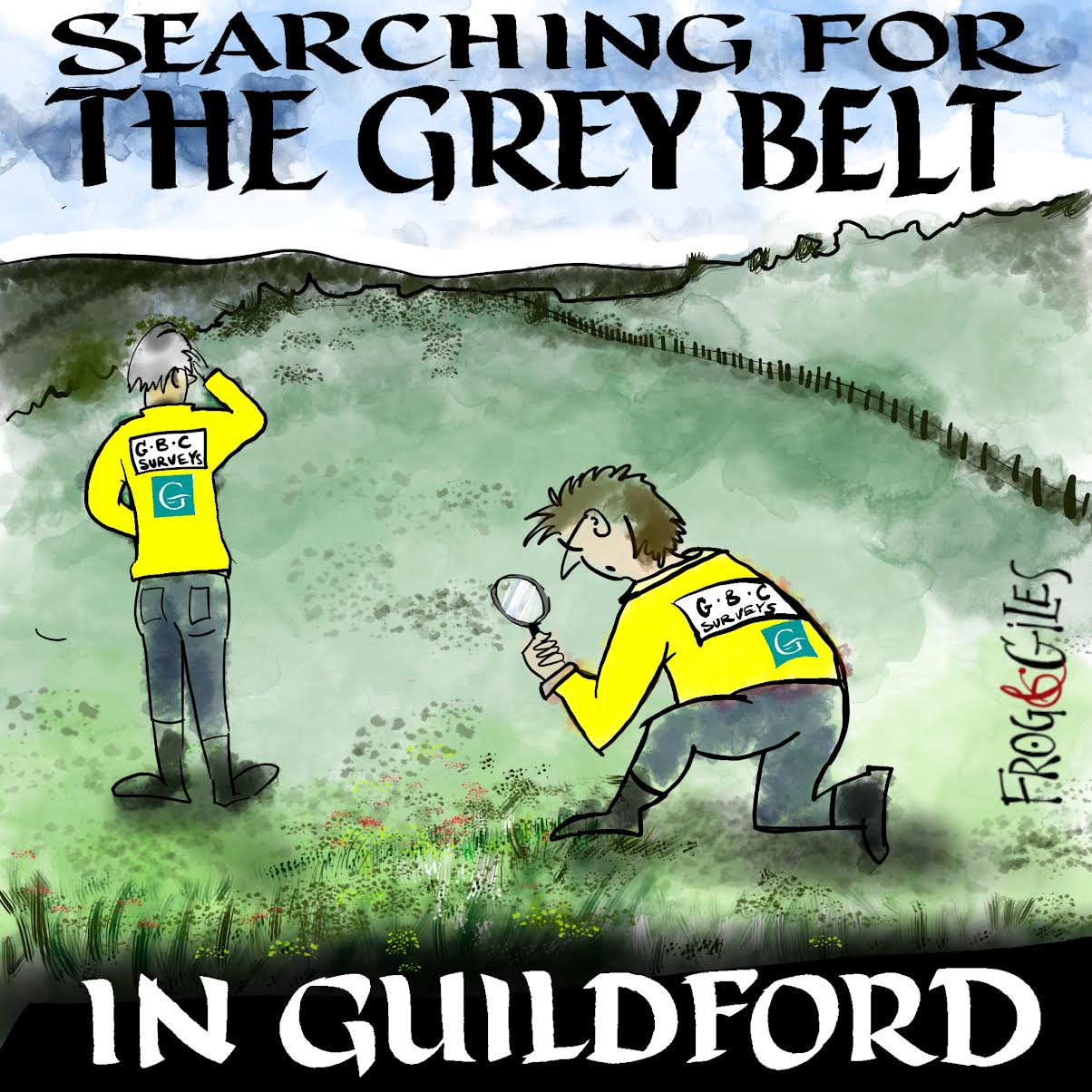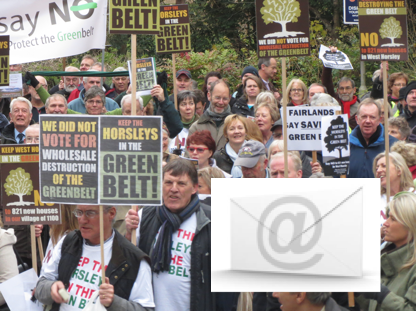 Abraham Lincoln
If given the truth, the people can be depended upon to meet any national crisis...
Abraham Lincoln
If given the truth, the people can be depended upon to meet any national crisis...
 Guildford news...
for Guildford people, brought to you by Guildford reporters - Guildford's own news service
Guildford news...
for Guildford people, brought to you by Guildford reporters - Guildford's own news service
Letter: Why I Marched on Friday and What The Council Should Do Now
Published on: 3 Dec, 2013
Updated on: 3 Dec, 2013
On Friday I went on a march in Guildford. For most of the marchers (including me), it was the first march we had ever been on. Estimates of the number there varied, but some press commentators thought there were more than 500 people. Anyway, it was a large gathering.
We were marching because we care about the green belt. Not just in my back yard, or even mine and yours too, but the green belt in Surrey. It is under attack, by the consultation document and by government policy. This is the Metropolitan green belt, set up for ever, for everyone.
The key purposes of the green belt, as a matter of law, are to check the unrestricted sprawl of large built up areas, to prevent neighbouring towns from merging into one another, to assist in safeguarding the countryside from encroachment, to preserve the setting and special character of historic towns; and to assist in urban regeneration by encouraging the recycling of derelict and other urban land. (National Planning Policy Framework (NPPF) 80, quoting previous law).
I’m not sure that the comments made in response to the march actually show that the strength of public feeling about this has yet been taken on board. In particular, we wanted to show the council, the councillors and the government that they are being held to account. The statements from Guildford Borough Council (GBC) and many councillors still show some rather complacent disregard for the anger that they have triggered.
GBC’s consultation document stated “we cannot automatically decide to keep all of our villages within the green belt”. Like many other statements made in the consultation document this involved some weasel wording. The National Planning Policy Framework (NPPF) does suggest that green belt boundaries should be reviewed at the Local Plan stage; but there is no obligation to change them.
There is a legal requirement under the NPPF to build on previously developed land first. And there is enough of such land in Guildford.
A cursory study of the Strategic Housing Land Availability Assessment (SHLAA), used by GBC in its consultation, showed a huge number of inconsistencies and apparent errors. For example: very low housing densities on a number of large brownfield sites (Walnut Tree Close, Merrow Depot where proposed densities were at 11 per hectare and 40 hectares at Slyfield is proposed at 24 per hectare. By comparison, Notting Hill, West London, is at 100 per hectare.) and; other sites excluded from consideration because they are reserved for commercial activity while being suitable for housing (Guildford Plaza, Portsmouth Road, Bedford Road and others).
Why were the council even thinking about keeping car parks and empty commercial space, and not building, yet, on the derelict land at Slyfield, while contemplating building any houses we might need on the green belt? Why were there any proposals to build on green fields in the consultation document at all, given the amount of brownfield land available? Why, unlike Mole Valley and other councils, did the consultation document not reflect the homes for which existing planning permission is in place? We are on the front line in the attempt to resist urban sprawl from London.
The first stage of the consultation has now closed, so no one can give comments to GBC for now. GBC have said that responses that they have received will be made public in the New Year. We were warned by the planning department that they might disregard certain responses if they felt that there was duplication; so everyone should check that their response has been taken into account. We can check online; there should be a public database.
There will be a formal draft plan next year, and we can then formally respond to GBC again in the second stage of the consultation.
We can keep reminding councillors of how we feel in the interim, and urge them to recognise our views in the votes in response to the petitions. The first petition is going to be debated by councillors on 12 December in response to the petition that, “We the undersigned, petition Guildford Borough Council to protect the Borough’s designated green belt and remove inappropriate large scale housing development from the Local Plan”.
Personally, I was disappointed by the recent press announcement from Sue Sturgeon, Managing Director of the borough council. In her response to the march, she stated, “Not everyone will be happy with all of the outcomes. As our population grows, we must accommodate the increasing needs of our community and the next generation. It must be a priority to provide decent and affordable homes for workers and people of all ages. Young people also need employment and more opportunities to work and live here, rather than move away.”
Actually, I think this is a little more weasel wording, dressed up as social concern. As has been previously stated, this consultation has taken place without any housing targets, which are actually a requirement of the Local Plan process. These will be published in the New Year, and we will look hard at the underlying assumptions and make sure that they are robust.
We do indeed need decent and affordable homes for people who need to live here. But that doesn’t necessarily mean everyone who works here, and we should not be taking any overspill from other areas.
Many of us spent some time responding at some length to some fundamentally faulty logic that is embedded in the consultation. Approximately 50% of the population of Guildford live here and work elsewhere. They don’t all need to work here: if the council hadn’t noticed, one of the largest cities in the world is only 45 minutes away.
Approximately 50% of the people who work in Guildford live elsewhere. That isn’t a problem; they may have partners who work close to their home or other reasons to live elsewhere, and it therefore makes sense for them to commute.
But generally, most people who live here are quite sensible and recognise that Guildford is not a closed system. People move around. We don’t live in the nineteenth century where people lived, worked and engaged in leisure activities all in the same place.
However, there is increasing use of smart technology, so that people work for a proportion of their time where they live, no matter where their legal employers and their formal workplace may be based. So, if an employer is based in Guildford, it doesn’t necessarily mean that we have to provide homes for all the employees of that business.
This must be taken into account in the Strategic Housing Market Assessment (SHMA), or it will be fundamentally flawed and not fit for purpose. Again, we expect our councillors to ensure that this is done.
There was no committee to review the remit of the SHMA, but we expect that our councillors to ensure that it does reflect our concerns, or it should be done again. A first draft will be available for councillors to see in mid December 2013 so we expect them to ensure that the numbers are reasonable and intelligently constructed, not an exercise in exaggerating demand in order to to facilitate development.
People should be aware that the housing targets agreed by Woking in their plan are 292 homes per annum. Godalming was forced to take higher targets after an inspector’s review. Following that process, it has accepted 8500 over 18 years (about 450 per year).
However, in publicising this, they have a stated ambition of keeping to their existing Local Plan and have informed local residents that they “will continue to lobby against policy that fails to recognise and protect the essence of what makes [their] borough a beautiful and prosperous place to live” [Source: Making Waves, Waverley Borough Council Winter 2013]. I would like to challenge our council to do the same.
Obviously we do need affordable homes for young people and those in need. But these can all be provided on the existing previously developed land and smaller homes will be more affordable because they will cost less to build. If this constrains the opportunities for property developers to build housing estates on green field sites, creating yet more urban sprawl, that is not a cause for regret.
Susan Parker is a chairman of a residents’ association near Shere, and part of the Save Shere, Gomshall and Abinger campaign.

"Found any?" - "Nope, it all looks green to me!" (See Opinion: The Future is Congested, the Future is Grey)




Recent Articles
- Mayor’s Diary – November 17 to December 1
- Ben Tries a Beryl
- Letter: Many Residents Appreciate LRAG
- Sara Sharif Trial Latest – Sara ‘Had a Different Status’ to Her Siblings
- Surrey Postcard Club’s Fair is Back, November 23, East Horsley Village Hall
- Guildford Residents Left Stranded After Heathrow Bus Breakdowns
- Mole Valley’s Finance Director Warns ‘All the Low Hanging Fruit Is Gone’
- Have Some Time to Volunteer?
- Council Tax Hike Not Currently Planned Despite ‘Black Hole’
- I Am Stella Kuchanny, The Dragon’s Newest Reporter


Search in Site
Media Gallery
Dragon Interview: Local Artist Leaves Her Mark At One of England’s Most Historic Buildings
January 21, 2023 / No Comment / Read MoreDragon Interview: Lib Dem Planning Chair: ‘Current Policy Doesn’t Work for Local People’
January 19, 2023 / No Comment / Read MoreA3 Tunnel in Guildford ‘Necessary’ for New Homes, Says Guildford’s MP
January 10, 2023 / No Comment / Read More‘Madness’ for London Road Scheme to Go Ahead Against ‘Huge Opposition’, Says SCC Leader
January 6, 2023 / No Comment / Read MoreCouncillor’s Son Starts Campaign for More Consultation on North Street Plan
December 30, 2022 / No Comment / Read MoreCounty Council Climbs Down Over London Road Works – Further ‘Engagement’ Period Announced
December 14, 2022 / No Comment / Read MoreDragon Interview: GBC Reaction to the Government’s Expected Decision to Relax Housing Targets
December 7, 2022 / No Comment / Read MoreHow Can Our Town Centre Businesses Recover? Watch the Shop Front Debate
May 18, 2020 / No Comment / Read More







Recent Comments